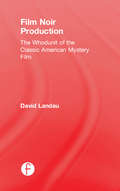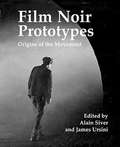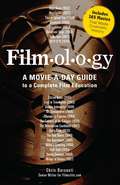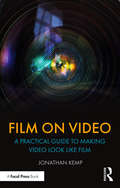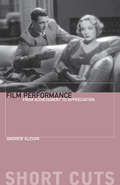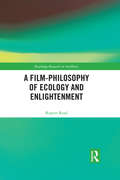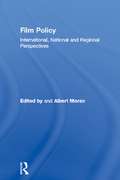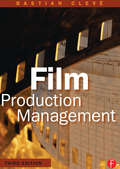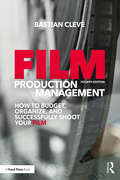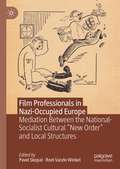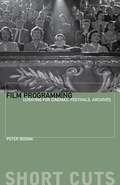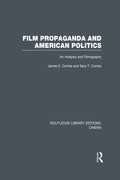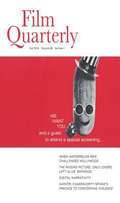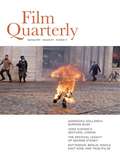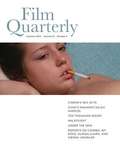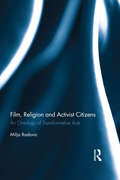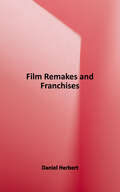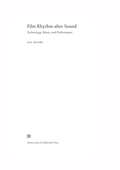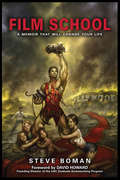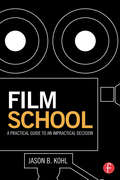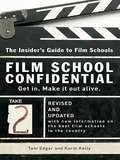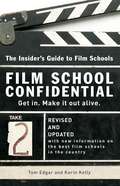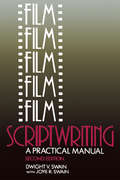- Table View
- List View
Film Noir Production: The Whodunit of the Classic American Mystery Film
by David LandauDavid Landau’s Film Noir Production: The Whodunit of the Classic American Mystery Film is a book meant for those who like a good story, one the Noir Films always delivered, concentrating on the characters more than anything else. Readers will find in these pages many behind-the-scenes tales of the productions of certain hard-boiled film classics and the prime players involved in their creation, from Darryl Zanuck and Raymond Chandler to John Seitz and Billy Wilder. This book features: A clear understanding of how movies are actually made and all the creative artists that contribute, creating a better appreciation for the many talented artistic collaborators that worked in the Hollywood Studio System and who together created film noir. A behind-the-scenes look at the making of a classic film noir movie that typifies the chapter’s subject, allowing the reader to view that film in a new light and think about it from a new prospective. Appendices of suggested films to screen, film noir books for further reading, and downloadable files containing discussion points and class assignments for each chapter. An informative and conversational writing style, making the subject matter easy to digest and fun to read. This book is an indispensible companion text for anyone studying or interested in film noir, film history, the bygone days of the Hollywood film factories or how movies are actually made.
Film Noir Prototypes: Origins of the Movement
by Alain Silver James UrsiniFilm noir is one of the most enduring and popular genres in cinema. But it did not spring up spontaneously, fully formed. Rather, its origins can be traced to sources as varied as Victorian literature, German Expressionism, and American art and photography. In this comprehensive collection of essays that's packed with illustrations and artwork, a team of eminent scholars and film writers present thorough analyses of the influence of prototypes on the classic period of film noir. Some essays focus on particularly influential genres, such as the rogue cop film and "gothic" thrillers; while others discuss the choices of individual filmmakers, including John Ford and Alfred Hitchcock, in their most well-loved films. The editors and all of the featured contributors Sheri Chinen Biesen, Todd Erickson, Richard Edwards, Julie Grossman, Robert Miklitsch, Homer Pettey, Robert Porfirio, Tom Ryall, Marlisa Santos, Jesse Schlotterbeck, and Tony Williams are noted scholars in the field of film noir, most of whom have written book-length studies of their own. From the gangster and horror genres to social realism and Hitchcock's spy films of the 1930s, Film Noir Prototypes offers compelling accounts of the genre's influences.
Film*ol*o*gy
by Chris BarsantiSure, you love the movies. But how much do you really know about the ones that really made a difference? Whether it's Birth of a Nation, the brilliant silent film that fanned the flames of racism; Easy Rider, the clarion call for a generation; or Inglourious Basterds, Tarantino's bloody take on art as propaganda, Filmology gives you the most entertaining crash course in good film ever produced-one movie a day. This is not just another greatest-movies celebration. Pairing cinema's lesser-seen gems alongside blockbusters, great early works from the pioneers of film alongside often-overlooked films from great directors, noted film critic Chris Barsanti unveils the movies that you must see-for your viewing pleasure. Filmology: So you can watch your way to an education in film!
Film on Video: A Practical Guide to Making Video Look like Film
by Jonathan KempFilm on Video: A Practical Guide to Making Video Look like Film is an accessible guide to making video captured on a camcorder, DSLR camera, smartphone, action camera or cinema camera look like it was shot on motion-picture celluloid film. Chapter by chapter, Jonathan Kemp introduces the reader to a key characteristic of celluloid film, explains the historical and practical reasons why it exists, before providing a simplified method for best replicating that characteristic on a digital camera. The book includes various practical exercises throughout that are designed to underline the takeaway principles of each chapter and features case studies on specific cameras including the Sony NX5 Camcorder, Canon 5D Mk IV, Canon 4000D, iPhone X, GoPro Hero 6, Blackmagic URSA Mini Pro 4.6K and Canon C200. Ideal for students studying film and media production and filmmaking newcomers who want to get up to speed quickly, this is an indispensable guide to how the numerous settings on a digital camera can be used to create footage that more closely resembles the film ‘look’.
Film Performance: From Achievement to Appreciation (Short Cuts)
by Andrew KlevanPerformers make a crucial contribution to the achievement of narrative films. By moving through exemplary sequences, this book closely follows the movement and behaviour of screen performers – Charlie Chaplin, Laurel and Hardy, Cary Grant, Katherine Hepburn, Marlene Dietrich, Barbara Stanwyck, Richard Widmark – and by emphasising their relationship to other aspects of film style – camera, location and plot – it develops accounts that are specific and involved. This study concentrates on films from the ‘Golden Age’ of Hollywood and moment-by-moment descriptions enable fresh interpretations to emerge and evolve. These reveal the significance and intensity of a performer’s engagement with the world of a film.
A Film-Philosophy of Ecology and Enlightenment (Routledge Research in Aesthetics)
by Rupert ReadInspired by the philosophy of Wittgenstein and his idea that the purpose of real philosophical thinking is not to discover something new, but to show in a strikingly different light what is already there, this book provides philosophical readings of a number of ‘arthouse’ and Hollywood films. Each chapter contains a discussion of two films—one explored in greater detail and the other analyzed as a minor key which reveals the possibility for the book's ideas to be applied across different films, registers, and genres. The readings are not only interpretive, but they offer a way of thinking and feeling about, with, and through films which is genuinely transformative. Rupert Read’s main contention is that certain films can bring about a change in how we see the world. He advocates an ecological approach to film-philosophy analysis, arguing that film can re-shape the viewer’s relationship to the environment and other living beings. The transformative 'wake-up call' of these films is enlightenment in its true sense. The result is a book that ambitiously aims to change, though film, how we think of ourselves and our place in the world, at a time when such change is more needed than ever before.
Film Policy: International, National and Regional Perspectives (Culture: Policy and Politics)
by Albert MoranFilm Policy is the first comprehensive overview of the workings of the international film industry. The authors examine film cultures and film policy across the world, explaining why Hollywood cinema dominates the global film market, and the effects of the rise of television and video on the international industry. In a series of case studies drawn from North America, Europe, Latin America, Asia and Australia, the authors explore the relationship between Hollywood cinema product and national film cultures, and trace the development of international and national film policies, looking at issues of financing, regulation, protectionism and censorship.
Film Production Management
by Bastian CleveFilm Production Management will tell you in step-by-step detail how to produce a screenplay and get it onto the big screen. Whether you are an aspiring or seasoned film professional, this book will be an indispensable resource for you on a day-to-day basis. This updated edition remains true to the practical, hands-on approach that has made previous editions so successful, and has been updated with revised forms, permits, and budgets applicable to all productions; contains important information on standards and typical processes and practices; includes the latest information available on technological advances such as digital FX; and discusses the impact of the Internet on filmmaking. Film production professionals at all levels of experience will benefit from the information in this handbook to film production management.
Film Production Management: How to Budget, Organize and Successfully Shoot your Film
by Bastian CleveThis new and updated fourth edition of Film Production Management provides a step-by-step guide on how to budget, organize, and successfully shoot a film and get it onto the big screen. Whether you are a film student or film production professional just getting started in the industry, this book is an indispensable resource for day-to-day business on the set. Written by veteran filmmaker Bastian Clevé, this book will teach you how to: Break down a screenplay Organize a shooting schedule Create a realistic budget Find and secure locations Network with agents to find actors Hire a crew and communicate effectively with unions The new edition features updated information on contracts, permits, and insurance; special tips for low-budget filmmaking; new information on digital workflows and production software; advice on green production practices; and expanded coverage of the role of the line producer.
Film Professionals in Nazi-Occupied Europe: Mediation Between the National-Socialist Cultural “New Order” and Local Structures
by Pavel Skopal Roel Vande WinkelThis book analyses the film industries and cinema cultures of Nazi-occupied countries (1939-1945) from the point of view of individuals: local captains of industry, cinema managers, those working for film studios and officials authorized to navigate film policy. The book considers these people from a historical perspective, taking into account their career before the occupation and, where relevant, pays attention to their post-war lives. The perspectives of these historical agents” contributes to an understanding of how top-down orders and haphazard signals from the occupying administration were moulded, adjusted and distorted in the process of their translation and implementation. This edited collection offers a more dynamic and less deterministic approach to research on the international expansion of Third-Reich cinema in World War Two; an approach that strives to balance the role of individual agency with the structural determinants. The case studies presented in this book cover the territories of Belgium, Czechoslovakia, France, the Netherlands, Norway, Poland and the Soviet Union.
Film Programming
by Peter BosmaThis book explores artistic choices in the field of cinema exhibition, focusing on film theatres, film festivals, and film archives, setting the various issues of film curating in their international context. The availability of artistic and commercial film has increased overwhelmingly as a result of the digitization of the infrastructure of distribution and exhibition; in this overflow of supply a reasoned and well-grounded selection is necessary more than ever. The conventional structures of the film trade are in a process of transformation and, in the digital age, supply and demand can meet without the intervention of traditional gatekeepers; everybody can be a film curator, in a passive or active way. This volume addresses three kinds of readers: those who want to become film curators themselves, or do research of the phenomenon of film curating, and those who are critical cinema visitors who want to investigate the story behind the process of selection of the available film supply and the way to present these films.
Film Programming: Curating for Cinemas, Festivals, Archives (Short Cuts)
by Peter BosmaThis study explores artistic choices in cinema exhibition, focusing on film theaters, film festivals, and film archives and situating film-curating issues within an international context. Artistic and commercial film availability has increased overwhelmingly as a result of the digitization of the infrastructure of distribution and exhibition. The film trade's conventional structures are transforming and, in the digital age, supply and demand can meet without the intervention of traditional gatekeepers—everybody can be a film curator, in a passive or active way. This volume addresses three kinds of readers: those who want to become film curators, those who want to research the film-curating phenomenon, and those critical cinema visitors who seek to investigate the story behind the selection process of available films and the way to present them.
Film Propaganda and American Politics: An Analysis and Filmography (Routledge Library Editions: Cinema #Vol. 4)
by James Combs Sara T. CombsOriginally published in 1994, this important book traces the rise of film propaganda in the 20th Century, discussing specifically how film can be used to manipulate public perception and opinions. Two distinct areas are covered: war propaganda, including feature and documentary films regarding warfare; and civilian propaganda, including films that address a variety of political subjects. Although the focus is American film and American politics, this book offers insights for all those interested in the affect of film on the minds of citizens of any country or state.
Film Quarterly Fall 2014
by B. Ruby RichFilm Quarterly has published substantial, peer-reviewed writing on cinema and media for nearly sixty years, earning a reputation as the most authoritative academic film journal in the United States, as well as an important English-language voice of cinema studies abroad.
Film Quarterly Spring 2014
by B. Ruby RichFilm Quarterly has published substantial, peer-reviewed writing on cinema and media for nearly sixty years, earning a reputation as the most authoritative academic film journal in the United States, as well as an important English-language voice of cinema studies abroad.
Film Quarterly Summer 2014
by B. Ruby RichFilm Quarterly has published substantial, peer-reviewed writing on cinema and media for nearly sixty years, earning a reputation as the most authoritative academic film journal in the United States, as well as an important English-language voice of cinema studies abroad.
Film, Religion and Activist Citizens: An ontology of transformative acts
by Milja RadovicFilm can be a socio-political and artistic-transformative cultural practice through which acts and activism are performed. Going beyond ideological constructs of activism and legal definitions of citizenship, this book offers a novel approach to understanding the ontology of acts and activist citizenship, particularly in the context of their expression through film. The author approaches film as act and focuses on the scene of film as a space that goes beyond representation, constituting its own reality through which activist citizens emerge. By looking at autonomous creative acts through a range of directors' works from across the world, the author explores both the ontological and ontic dimensions of transformative acts of citizenship. In doing this the author poses the question of whether citizens are stepping out of dominant cultural ideologies to overcome social, ethnic, religious and economic divisions. This book is a fresh exploration of the ontology of acts and is essential reading for any academic interested in religion, theology, film and citizenship studies.
Film Remakes and Franchises (Quick Takes: Movies and Popular Culture)
by Daniel HerbertContemporary media seems incredibly unoriginal, as Hollywood produces an endless flood of remakes, sequels, reboots, and franchises. We watch as the same stories, characters, and images appear again and again in different films, on new platforms, and as toys and other merchandise. Are these works simply crass commercial products, utterly devoid of creativity, or do they offer filmmakers a unique opportunity to reimagine iconic characters and modern myths? <p><p>Film Remakes and Franchises examines how remakes and sequels have been central to the film industry from its very inception, yet also considers how the recent trends toward reboots and transmedia franchises depart from those historical precedents. Film scholar Daniel Herbert not only analyzes the film industry's increasing reliance on recycled product but also asks why audiences are currently so drawn to such movies. In addition, he explores how contemporary filmmakers have used reboots and franchise movies to inject timely social commentary and diversity into established media properties. <p><p>A lively and accessible overview that covers everything from You've Got Mail to The Force Awakens, Film Remakes and Franchises raises essential questions about the intersection of business and creativity in Hollywood today.
Film Rhythm after Sound
by Lea JacobsThe seemingly effortless integration of sound, movement, and editing in films of the late 1930s stands in vivid contrast to the awkwardness of the first talkies. Film Rhythm after Sound analyzes this evolution via close examination of important prototypes of early sound filmmaking, as well as contemporary discussions of rhythm, tempo, and pacing. Jacobs looks at the rhythmic dimensions of performance and sound in a diverse set of case studies: the Eisenstein-Prokofiev collaboration Ivan the Terrible, Disney's Silly Symphonies and early Mickey Mouse cartoons, musicals by Lubitsch and Mamoulian, and the impeccably timed dialogue in Hawks's films. Jacobs argues that the new range of sound technologies made possible a much tighter synchronization of music, speech, and movement than had been the norm with the live accompaniment of silent films. Filmmakers in the early years of the transition to sound experimented with different technical means of achieving synchronization and employed a variety of formal strategies for creating rhythmically unified scenes and sequences. Music often served as a blueprint for rhythm and pacing, as was the case in mickey mousing, the close integration of music and movement in animation. However, by the mid-1930s, filmmakers had also gained enough control over dialogue recording and editing to utilize dialogue to pace scenes independently of the music track. Jacobs's highly original study of early sound-film practices provides significant new contributions to the fields of film music and sound studies.
Film School: A Memoir
by Steve BomanOne L meets You'll Never Eat Lunch in This Town AgainIn this comic and moving and completely true tale, Film School reveals what life is like at the elite school that trained Hollywood's biggest names.When Midwestern journalist Steve Boman applied to the University of Southern California's vaunted School of Cinematic Arts, the world's oldest and most prestigious film school, he had more than a few strikes against him: His wife was recovering from thyroid cancer. His beloved sister had just died of leukemia. He lost his job. He had three young children. He was in his late 30s.... And he had no experience in filmmaking.As Boman navigates his way through USC's arduous three-year graduate production program, he finds that his films fall flat, he's threatened with being kicked out of the program and he becomes the old guy no one wants to work with. Defeated, he quits and moves back to the Midwest to be with his family. After he is urged by his wife to reapply, he miraculously gets in for a second time...only to have a stroke on the first day of classes. But instead of doing the easy thing - running away again -- Boman throws caution to the wind and embraces the challenge. He slowly becomes a gray-haired Golden Boy at USC with films that sparkle. And then he does the impossible: While still in school, for a class project, he dreams up a television series that CBS catches wind of and develops into THREE RIVERS, a primetime Sunday night show.This story of challenge and triumph-and what it takes to make it in the world's most famous film school-is a must-read for anyone aspiring to become a Hollywood great or anyone just looking for a good story.
Film School: A Practical Guide to an Impractical Decision
by Jason B. KohlDevelop the tools you will need to succeed before, during, and after your film school education. Film School: A Practical Guide to an Impractical Decision is a specific, straightforward guide to applying, getting into, and thriving in film school and in the industry in general. Not only does this book appeal to both prospective and current film students, it also features an in depth discussion of the application process, both from the graduate and undergraduate perspectives. You will learn how to choose between different schools and programs, avoid debt, succeed at festivals, and transition out of film school and into the work world. Author Jason Kohl offers: Tips on how to develop your voice before attending film school A chronological layout that allows you to continually refer to the book throughout your film school process Advice on how to gauge the cost of attending film school Whether you are a recent film school graduate, or just starting the application process, Film School gives important advice and insider knowledge that will help you learn and grow in the film industry. Film School is a must-have for anyone who wants to know what it takes to succeed in film school and beyond.
Film School: A Practical Guide to an Impractical Decision
by Jason B. KohlDevelop the tools you will need to succeed before, during, and after your film school education. Film School: A Practical Guide to an Impractical Decision is a specific, straightforward guide to applying, getting into, and thriving in film school and in the industry in general. Not only does this book appeal to both prospective and current film students, it also features an in depth discussion of the application process, both from the graduate and undergraduate perspectives. You will learn how to choose between different schools and programs, avoid debt, succeed at festivals, and transition out of film school and into the work world. Author Jason Kohl offers: Tips on how to develop your voice before attending film school A chronological layout that allows you to continually refer to the book throughout your film school process Advice on how to gauge the cost of attending film school Whether you are a recent film school graduate, or just starting the application process, Film School gives important advice and insider knowledge that will help you learn and grow in the film industry. Film School is a must-have for anyone who wants to know what it takes to succeed in film school and beyond.
Film School Confidential
by Tom EdgarEvaluates twenty-six film school programs in the United States, offers tips on the application and admission process, and includes comments from students and faculty.
Film School Confidential: An Insider's Guide to Film Schools
by Tom Edgar Karin KellyThis completely revised edition of Film School Confidential continues to offer the inside scoop on every major film school program in the country. A must-have guide for students who are considering applying to film school, this book provides more than 20 profiles of the best film school programs across the country. Covering such key areas as curriculum, student body, reputation, and employment options for film school grads, the authors provide solid, objective information on each program as well as snippets from interviews with students and faculty members.
Film Scriptwriting: A Practical Manual
by Dwight V Swain Joye R SwainThis second edition of the widely acclaimed Film Scriptwriting is a truly practical manual for the working writer. It provides all the clear, step-by-step guidance you need to script both fact and feature film and video - from getting and developing ideas to the writing of master scene or shooting script. Featured in this new edition are annotated excerpts from some of today's most successful films, selected to point up principles and techniques discussed. Interviews with working film specialists reveal the things professional directors, producers, story editor, and analysts look for in appraising the scripts that come across their desks.
